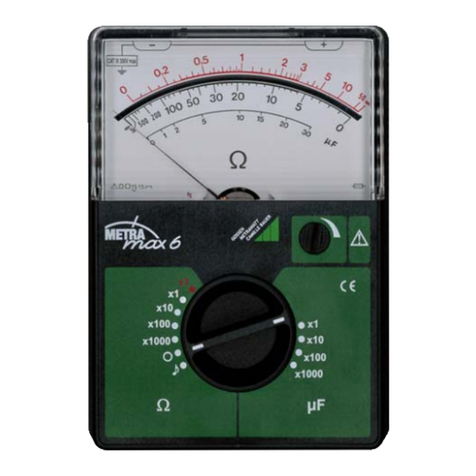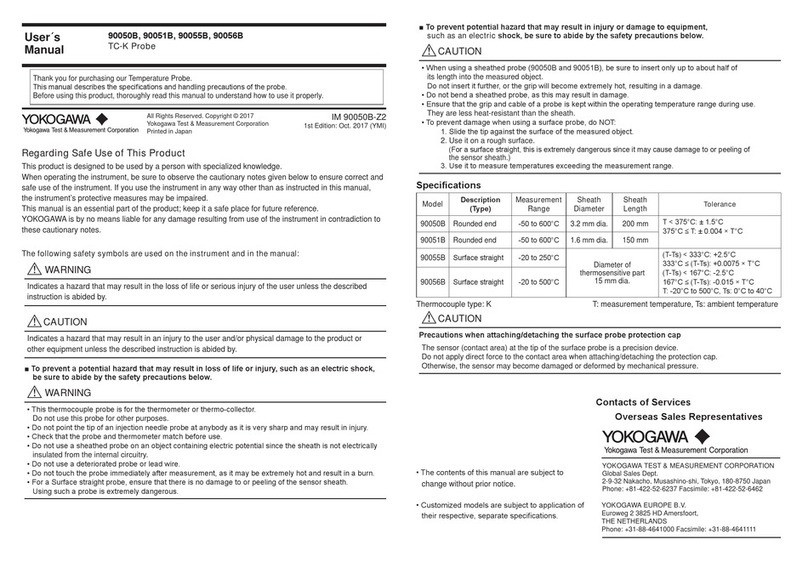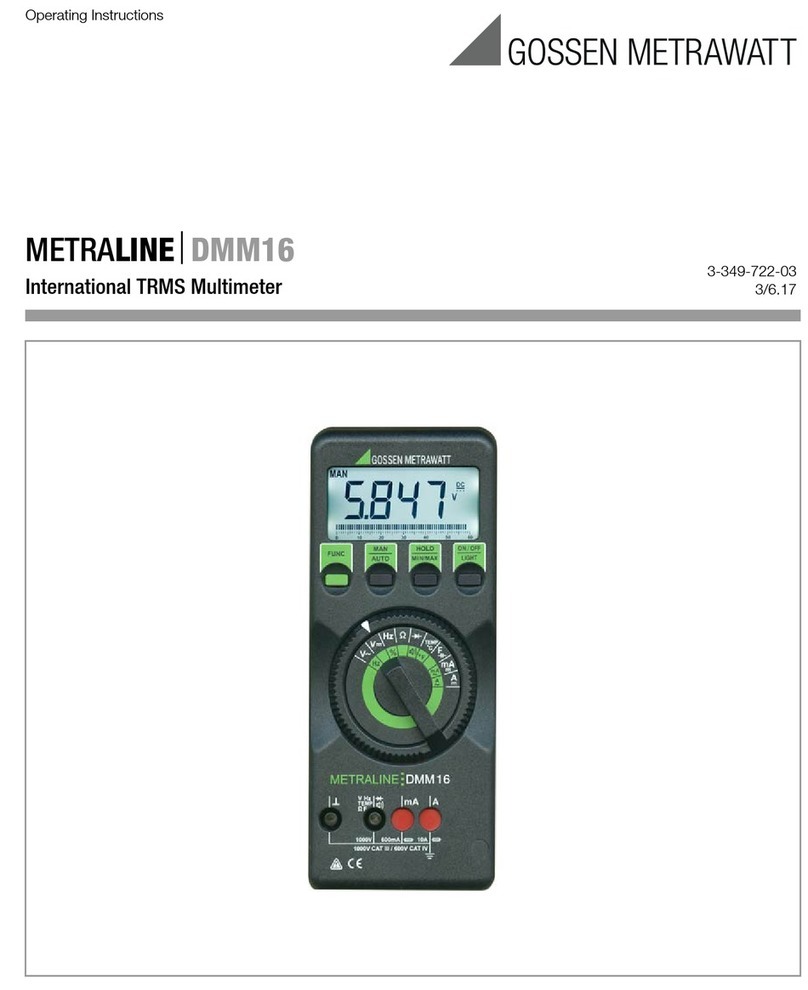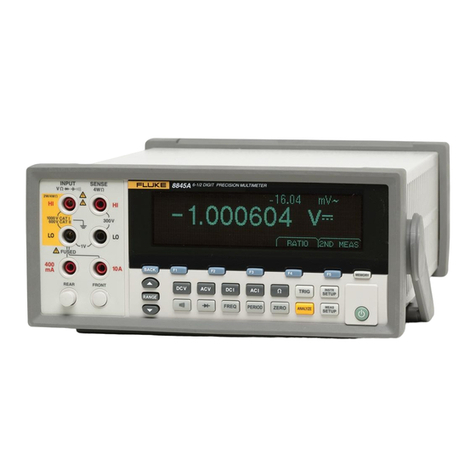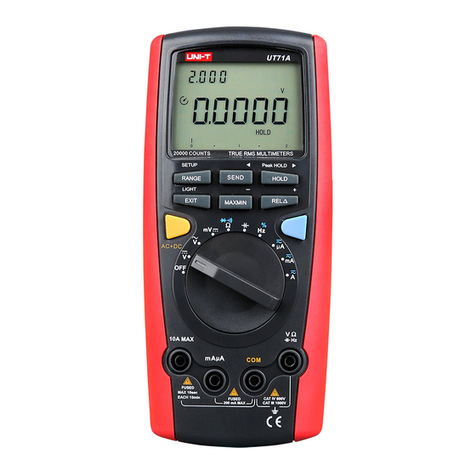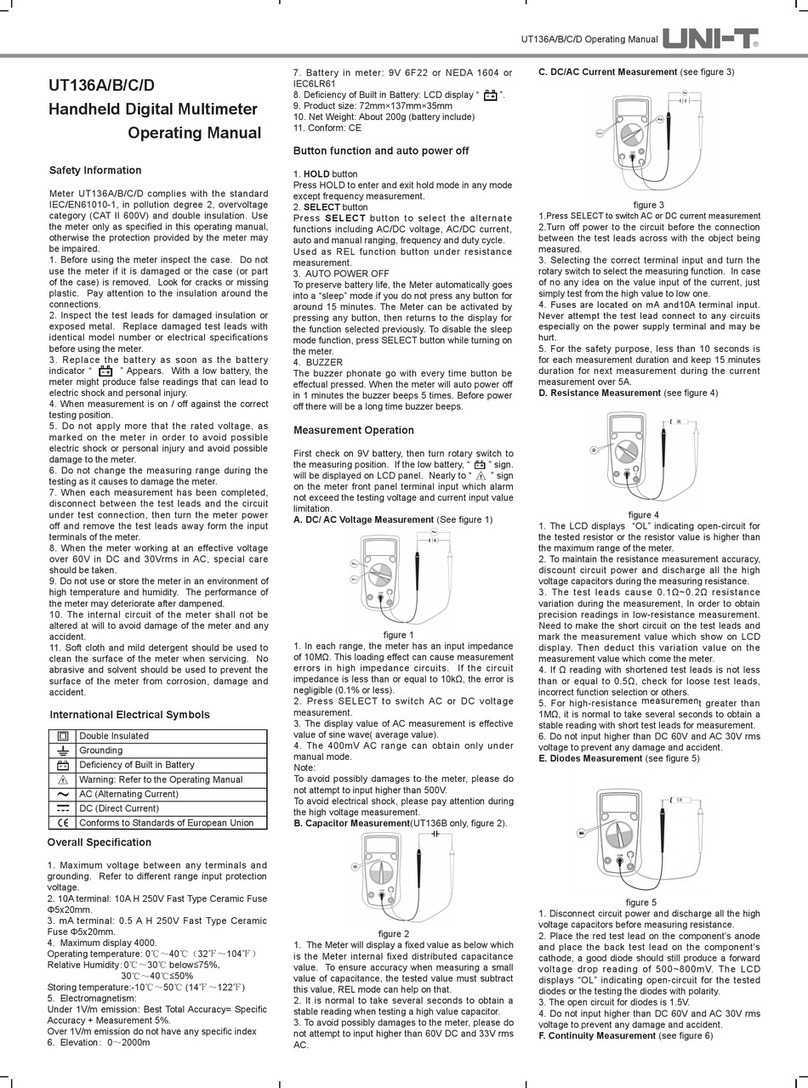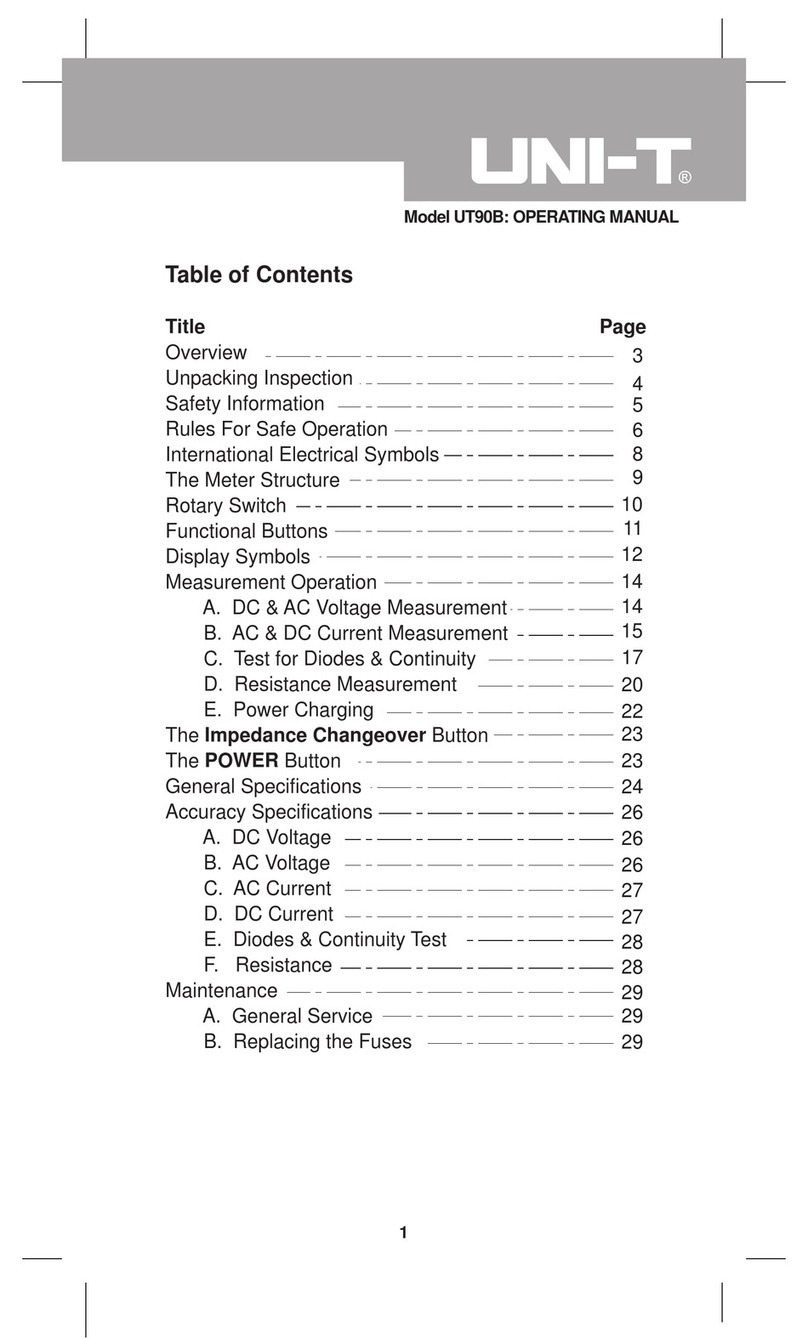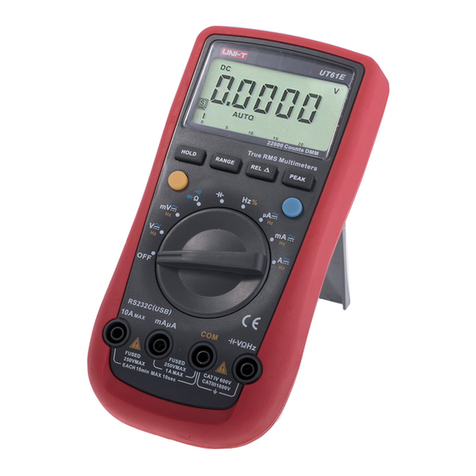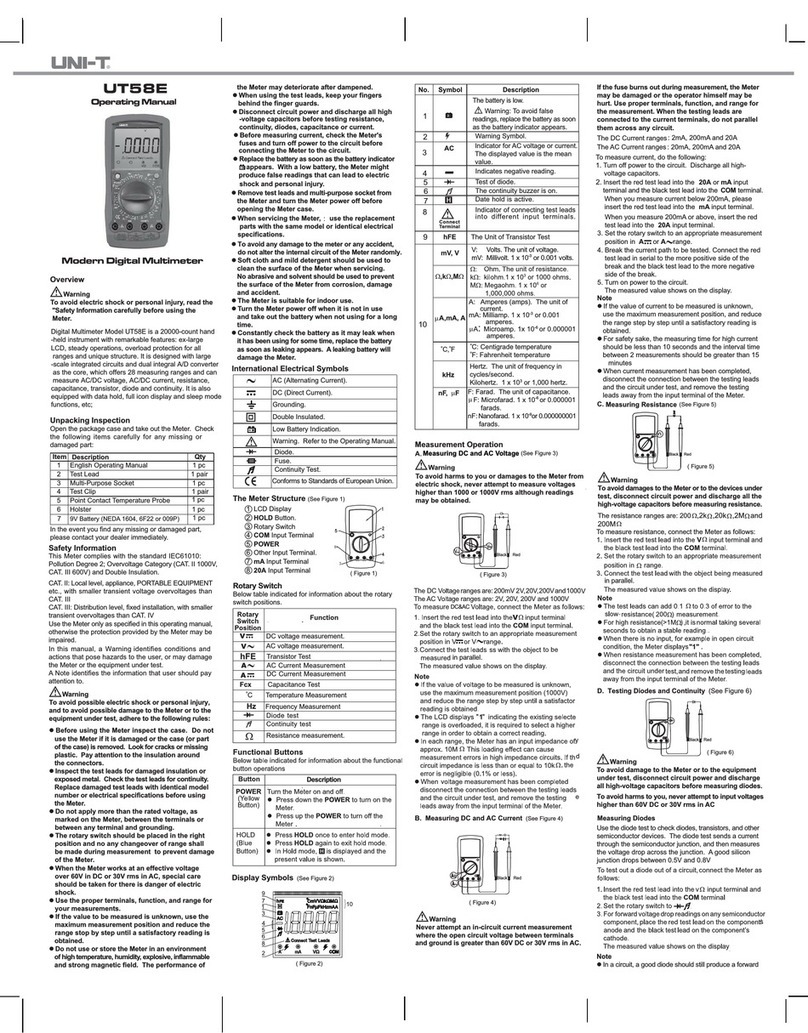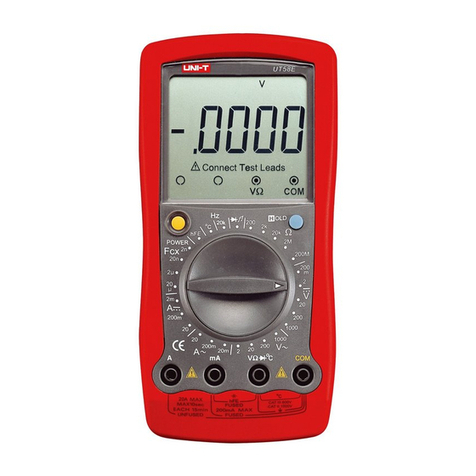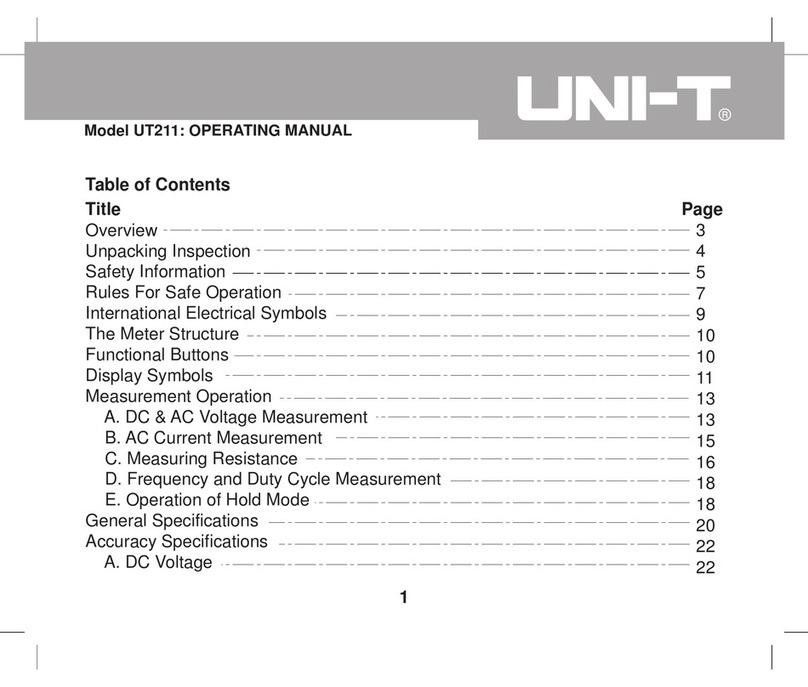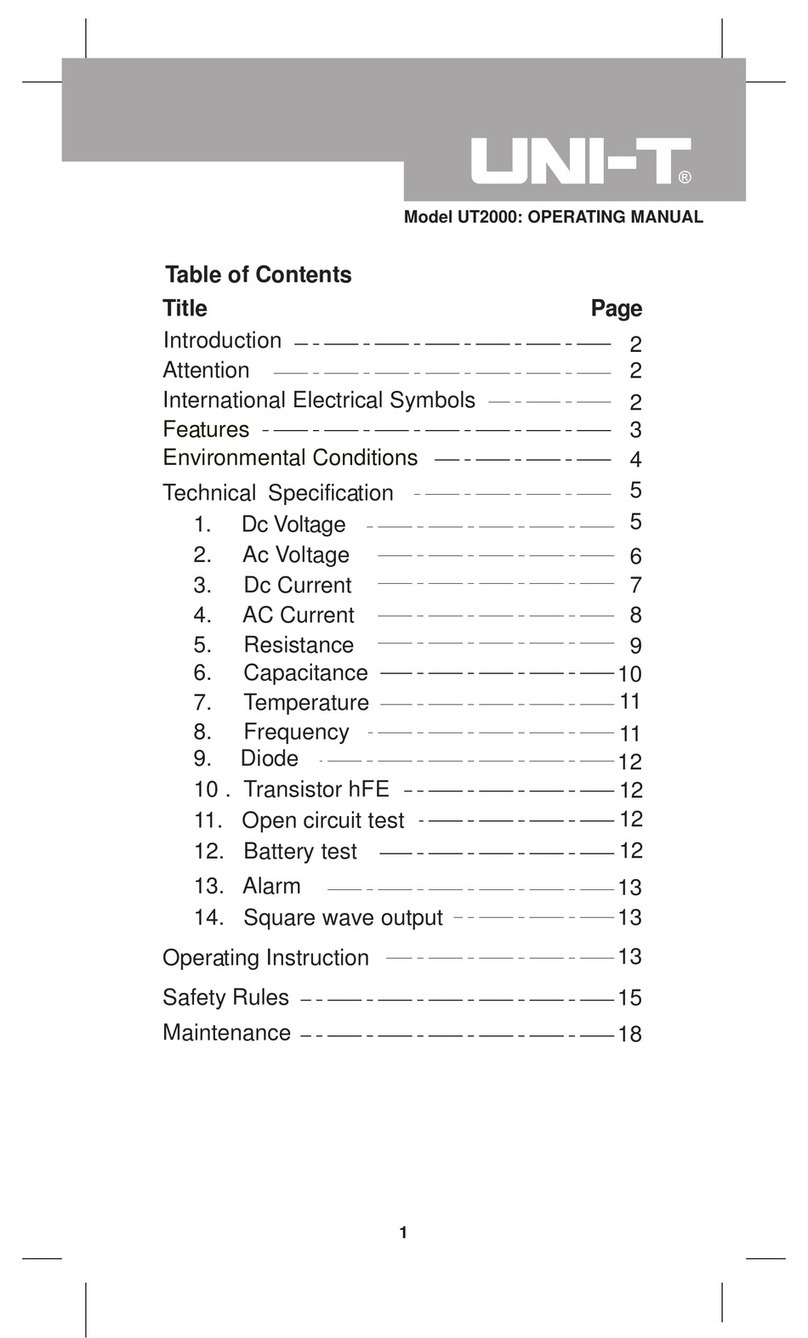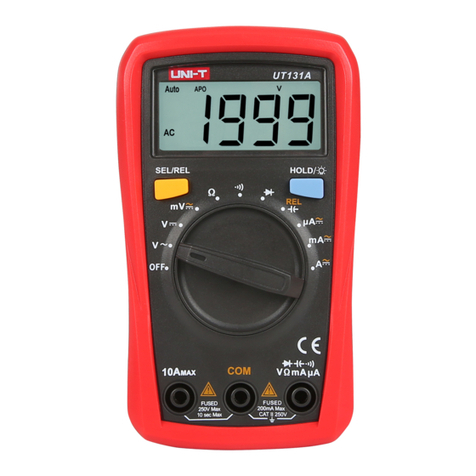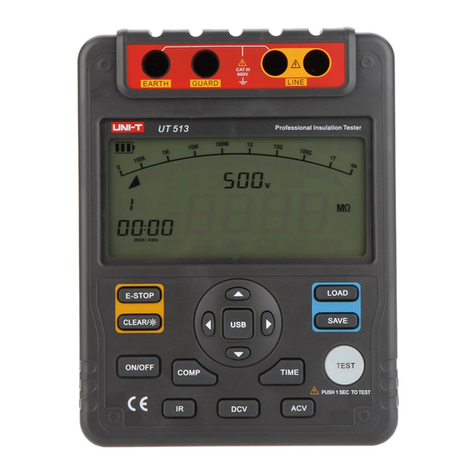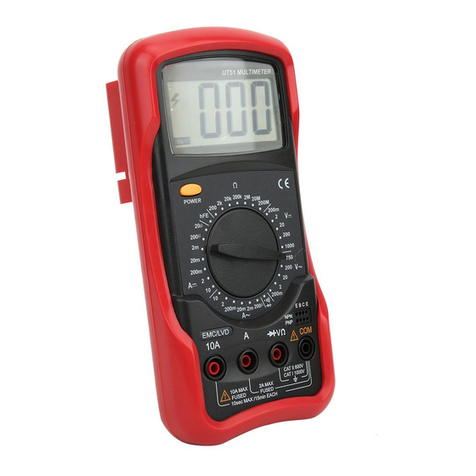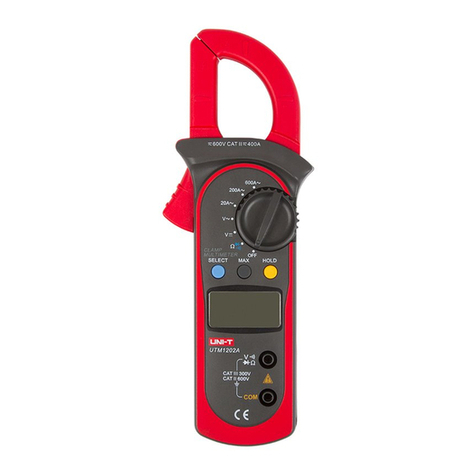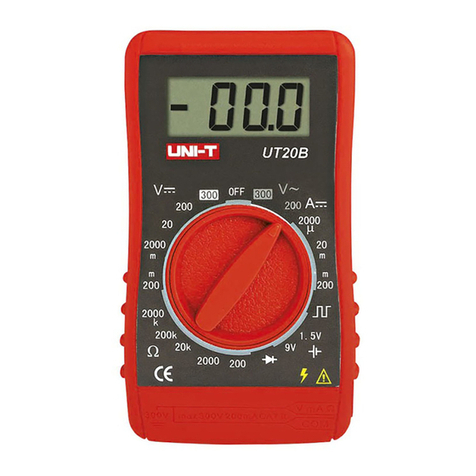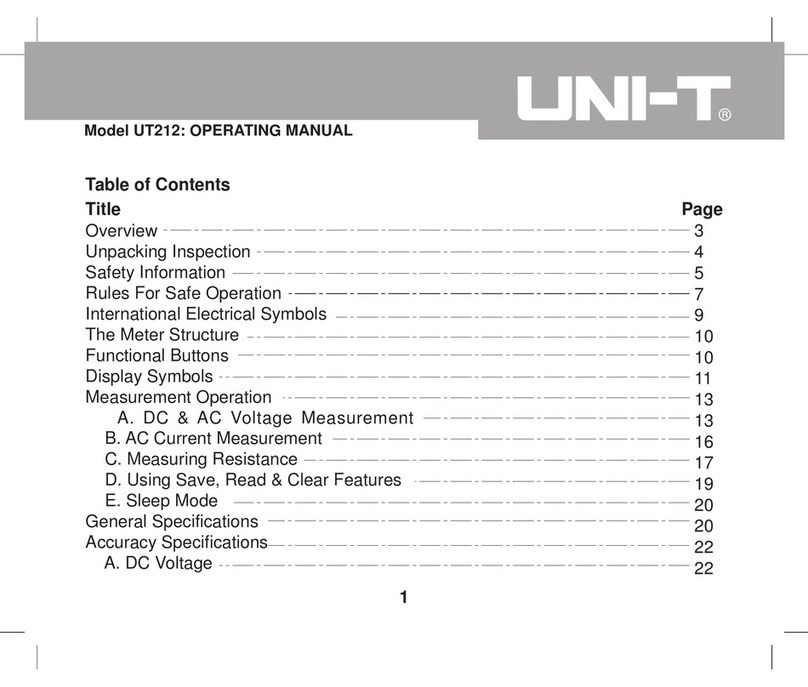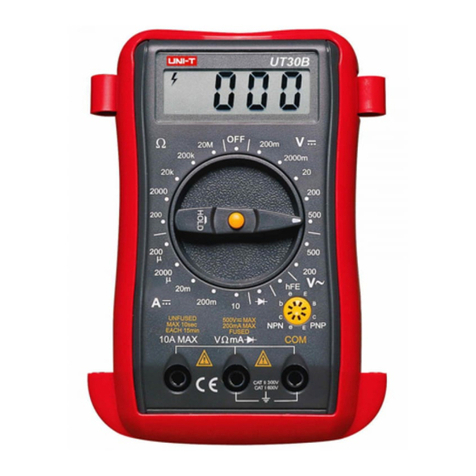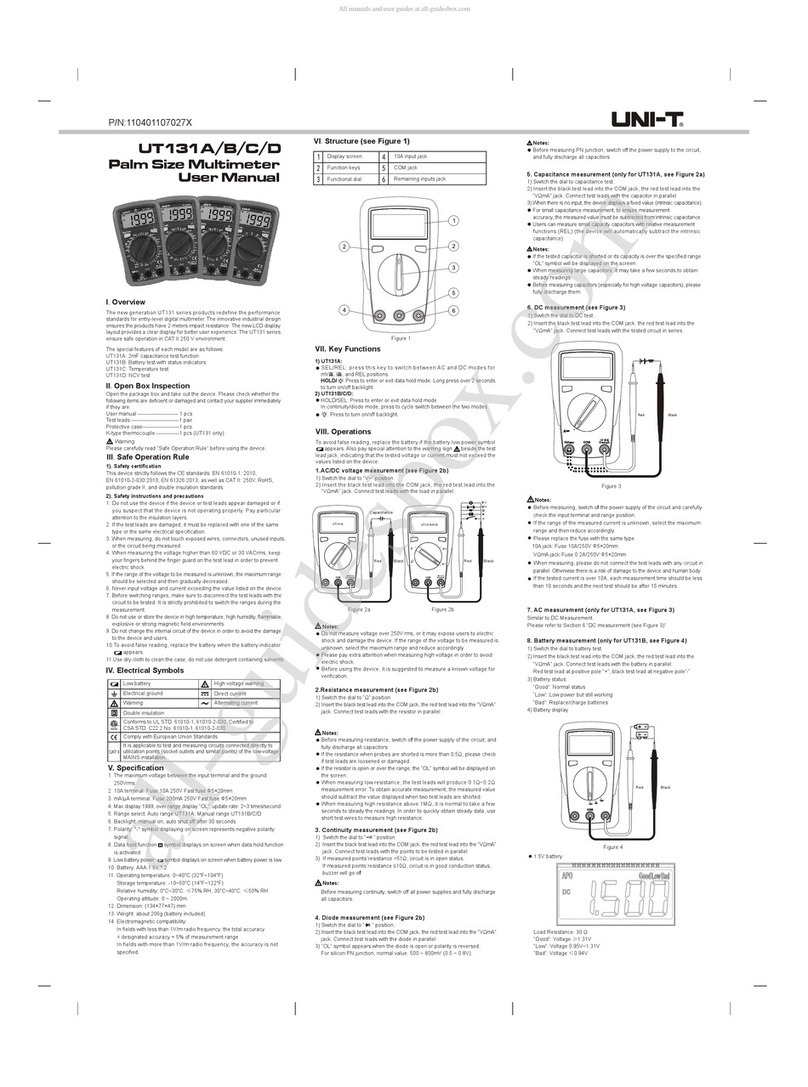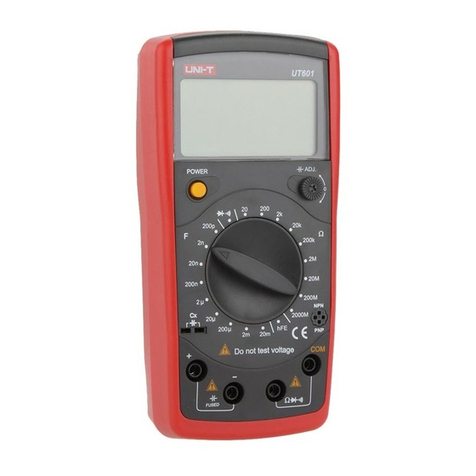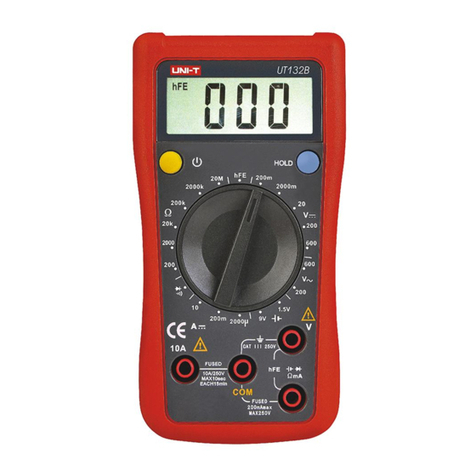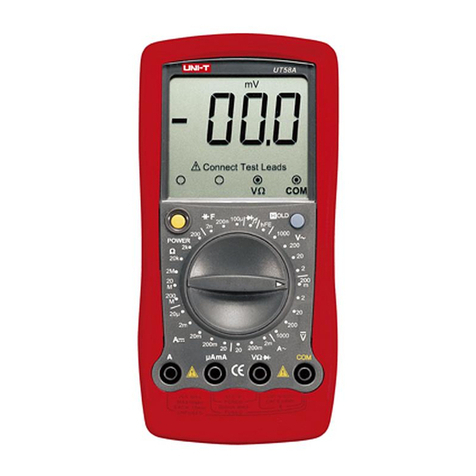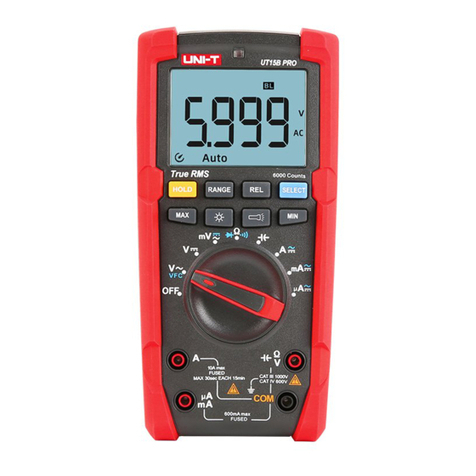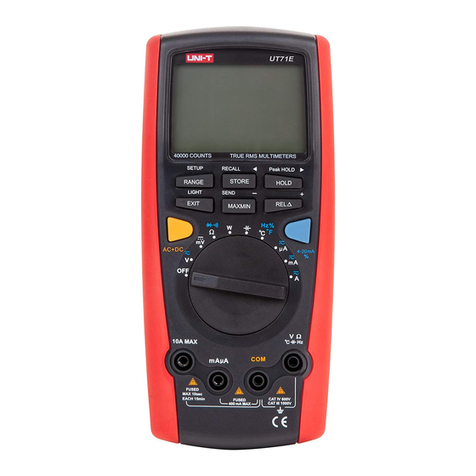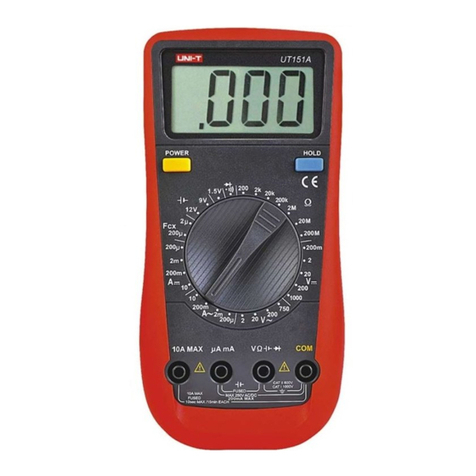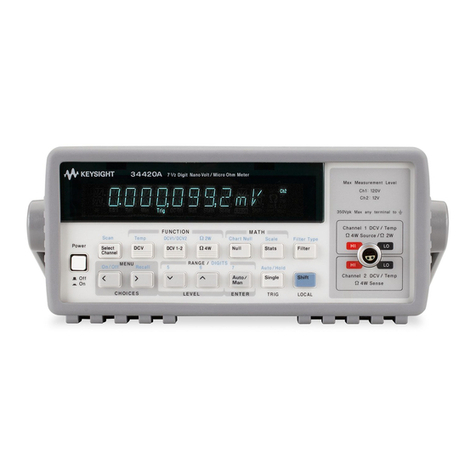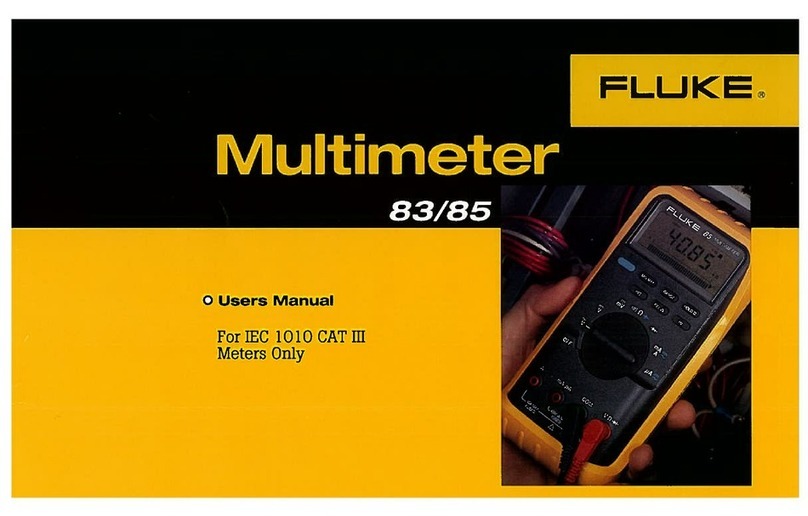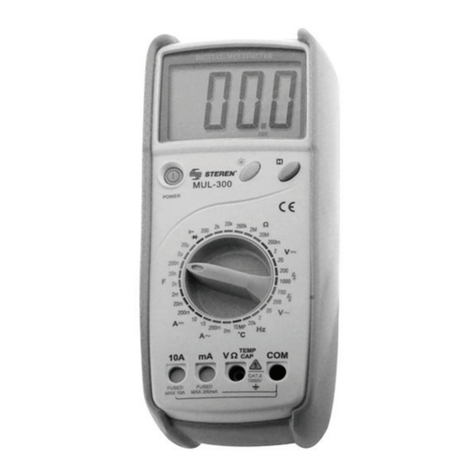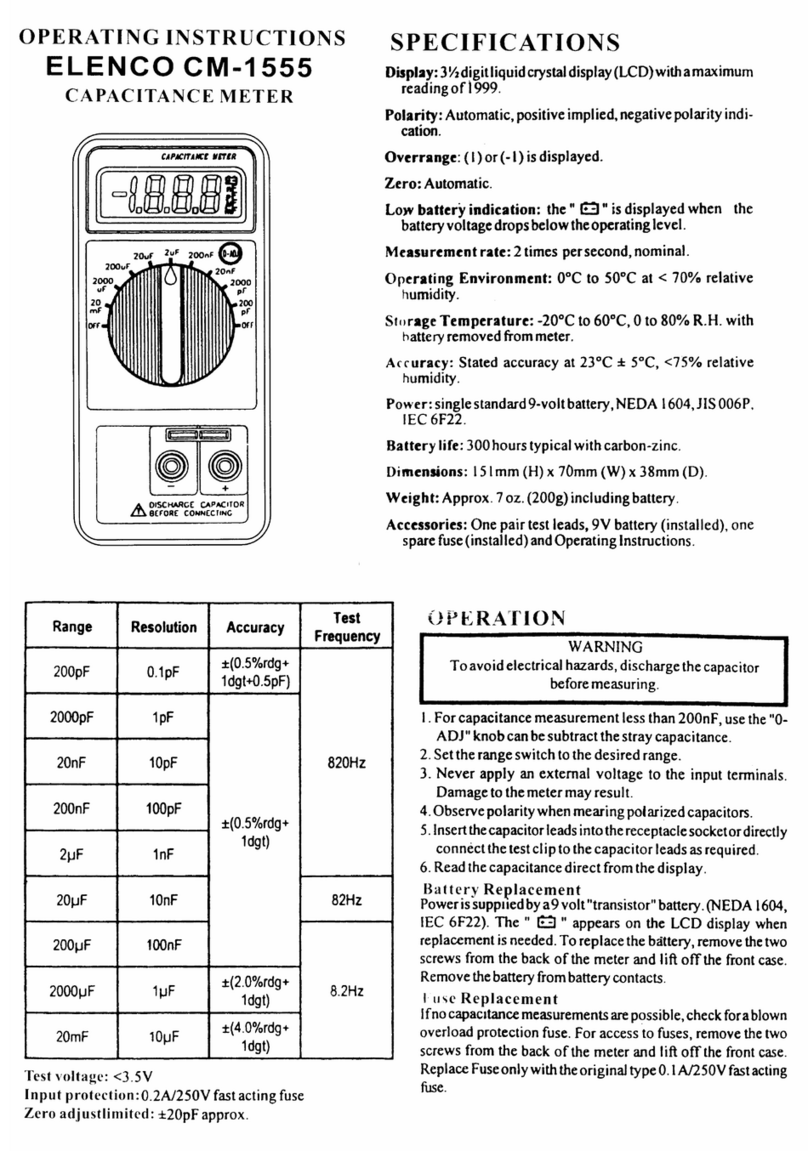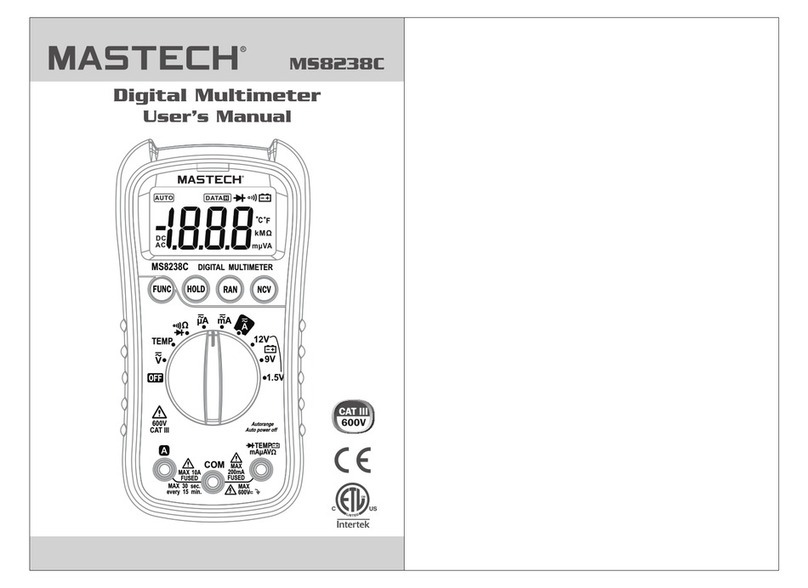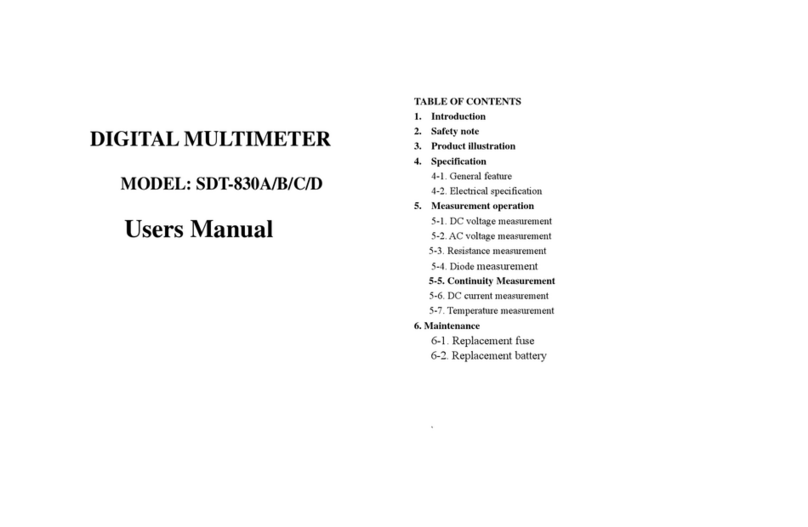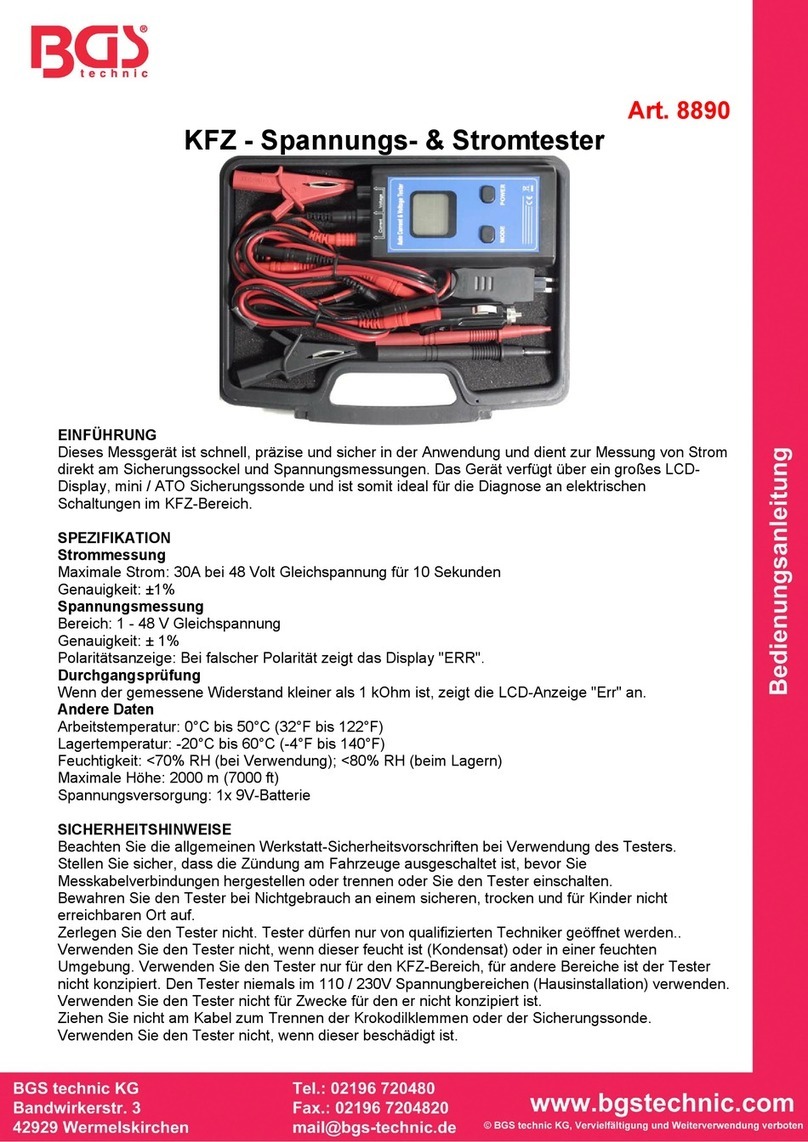Overview
This Operating Manual covers information on safety and cautions. Please read
the relevant information carefully and observe all the Warnings and Notes strictly.
Warning
To avoid electric shock or personal injury, read the “Safety Information”
carefully before using the Meter.
The Meter can measure AC/DC Voltage, AC/DC Current, Frequency, Duty Cycle,
Resistance, Diodes, Continuity and etc.
UT208A has extra temperature and Capacitance features.
Unpacking Inspection
Open the package case and take out the Meter. Check the following items
carefully for any missing or damaged part:
Item Description Qty
1 English Operating Manual 1 pc
2 Test Lead 1 pair
3 Point Contact Temperature Probe (Only UT208A) (This
included point contact temperature probe can only be used
up to 230ć. For any measurement is higher than that, the
rod type temperature probe must be used)
4 Tool box 1pc
5 9V Battery (NEDA1604A or 6LF22) 1 pc
In the event you ¿QG any missing or damaged part, please contact your dealer
immediately.
1 pair
Safety Information
This Meter complies with IEC61010, Pollution Degree 2, Overvoltage Category
(CAT.Ⅱ600V, CAT Ⅲ300V) and Double Insulation standards.
CAT II: Local level, appliance, PORTABLE EQUIPMENT etc., with smaller
transient overvoltages than CAT III.
CAT III: Distribution level, ¿[HG installation, with smaller transient overvoltages than CAT IV.
Use the Meter only as VSHFL¿HG in this operating manual, otherwise the protection
provided by the Meter may be impaired.
In this manual, a Warning identL¿HV conditions and actions that pose hazards to
the user, or may damage the Meter or the equipment under test.
A Note identL¿HV the information that user should pay attention to.
Warning
To avoid possible electric shock or personal injury, and to avoid possible damage
to the Meter or to the equipment under test, adhere to the following rules:
ƔBefore using the Meter inspect the case. Do not use the Meter if it is
damaged or the case (or part of the case) is removed. Look for cracks or
missing plastic. Pay attention to the insulation around the connectors.
ƔInspect the test leads for damaged insulation or exposed metal. Check
the test leads for continuity. Replace damaged test leads with identical
model number or electrical VSHFL¿FDtions before using the Meter.
ƔDo not apply more than the rated voltage, as marked on the Meter, between
the terminals or between any terminal and grounding. If the value to be
measured is unknown, use the maximum measurement position and reduce
the range step by step until a satisfactory reading is obtained.
ƔWhen measurement has been completed, disconnect the connection
between the test leads and the circuit under test, remove the testing leads
away from the input terminals of the Meter and turn the Meter power off.
ƔThe rotary switch should be placed in the right position and no any
changeover of range shall be made during measurement to prevent damage
of the Meter.
ƔDo not carry out the measurement when the Meter’s back case and battery
compartment are not closed to avoid electric shock.
ƔDo not input higher than 1000V in DC or 750 V in AC between the two
Meter’s input terminal to avoid electric shock and damages to the Meter.
ƔWhen the Meter is working at an effective voltage over 70V in DC or 33V rms
in AC, special care should be taken for there is danger of electric shock.
ƔUse the proper terminals, function, and range for your measurements.
ƔDo not use or store the Meter in an environment of high temperature,
humidity, explosive, LQÀDPPDEOH and strong magnetic ¿HOG. The performance
of the Meter may deteriorate after dampened.
ƔWhen using the test leads, keep your ¿QJHUV behind the ¿nger guards.
ƔTo avoid electric shock, do not touch the bare wires, connectors, unused
input terminals or the circuit under testing during measurement.
ƔDisconnect circuit power and discharge all high-voltage capacitors before
testing resistance, continuity and diode.
ƔReplace the battery as soon as the battery indicator appears. With a low
battery, the Meter might produce false readings that can lead to electric
shock and personal injury.
ƔWhen servicing the Meter, use only the replacement parts with the same
model or identical electrical specifications.
ƔThe internal circuit of the Meter shall not be altered at will to avoid damage
of the Meter and any accident.
ƔSoft cloth and mild detergent should be used to clean the surface of the
Meter when servicing. No abrasive and solvent should be used to prevent
the surface of the Meter from corrosion, damage and accident.
ƔThe Meter is suitable for indoor use.
ƔTurn the Meter off when it is not in use and take out the battery when not
using for a long time.
ƔConstantly check the battery as it may leak when it has been using for some
time, replace the battery as soon as leaking appears. A leaking battery will
damage the Meter.
International Electrical Symbols
Double Insulated
Grounding
Warning. Refer to the Operating Manual
AC (Alternating Current)
DC (Direct Current)
Continuity Test
Diode
Low Battery Indication
AC or DC
Danger of High Voltage
Conforms to Standards of European Union
The Meter Structure
(See Figure 1)
ķHand Guards: to protect user’s hand from
touching the dangerous area.
ĸLever: press the lever to open the
transformer jaws. When the lever is
released, the jaws will close.
ĹFunctional Buttons
ĺInput Terminals
ĻLCD Display
ļRotary Switch
ĽTransformer Jaw: designed to pick up the AC
and DC current ÀRZLQJ through the conductor.
It could transfer current to voltage. The tested
Figure 1
Display Symbols
(See Figure 2)
Figure 2
1. Test of diode
2. The continuity buzzer is on
3. Indicator for zeroing
4. Data hold is active
5. The Meter is in the auto range mode in
which the Meter automatically selects
the range with the best resolution.
6. True RMS indicator
7. Indicator for AC voltage or current
8. Indicates negative reading
9. Indicator for DC voltage
10. The battery is low.
Warning: To avoid false readings, which could lead to possible electric shock
or personal injury, replace the battery as soon as the battery indicator appears.
11. The unit of transistor hEF
12. The unit of temperature, ć: Centigrade temperature
13. The unit of temperature, : Fahrenheit temperature
14. The unit of capacitance (UT208A only)
15. Volts. The unit of voltage. mV: Millivolt.
16. Amperes (amps). The unit of current.
17. The unit of resistance. (¡: Ohm, k¡:Kilohm, M¡:Megohm )
conductor must vertically go through the Jaw center.
18. The unit of frequency. (Hz: Hertz, KHz: Kilohertz, MHz: Meghertz)
19. Duty cycle measurement
Functional Buttons
Below table indicated for information about the functional button operations.
SELECT
RANGE
HOLD
Button Operation Performed
Press SELECT button to select the alternate functions including
V , A and . ( UT208A only)
ȍ
Range feature: Exit AUTO and enter MANUAL ranging. In MANUAL,
select next input range. EXIT to return to AUTO. AUTO is default.
Press once to turn the display backlight on. Press again to turn the
display backlight off, otherwise it will automatically off after 15 seconds.
ƔPress HOLD to enter the Hold mode in any mode (except
%Hz), the Meter beeps.
ƔPress HOLD again to exit the Hold mode to return to
measurement mode, the Meter beeps.
ƔTurn the rotary switch or press any button can also exit hold mode.
ZERO
When the Meter is at %Hz, V and A , press %Hz to
measure frequency and duty cycle.
Press ZERO to zeroing the display before measuring AC/DC
voltage, AC/DC current, resistance and capacitance.
Hz%
Automatic Power Off
The display blanks and the Meter goes into a “sleep” mode if you have not
changed the rotary switch position or pressed a button for 15 minutes. While
in Sleep mode, pressing the any effective Functional button or turning the
rotary switch could turn the Meter on. To disable the sleep mode function, press
SELECT button while turning on the meter.
The Effectiveness of Functional Buttons
Not every functional buttons can be used on every rotary switch positions. Below
table describe which functional buttons can be used on which rotary switch positions.
V
¡
%Hz
40A
400A
1000A
ć
Rotary Switch Functional Buttons
Positions SELECT RANGE HOLD ZERO
%Hz
Ɣ
Ɣ
N/A
N/A
Ɣ
Ɣ
Ɣ
N/A
Ɣ
N/A
Ɣ
N/A
N/A
N/A
N/A
N/A
Ɣ
Ɣ
Ɣ
Ɣ
Ɣ
Ɣ
Ɣ
Ɣ
Ɣ
Ɣ
Ɣ
N/A
Ɣ
Ɣ
Ɣ
Ɣ
Ɣ
N/A
N/A
Ɣ
Ɣ
Ɣ
Ɣ
N/A
Ɣ
Ɣ
Ɣ
N/A
Ɣ
Ɣ
Ɣ
N/A
Measurement Operation
A. Measuring DC/AC Voltage (See Figure 3)
Figure 3
To avoid harm to you or damage to the
Meter from eletric shock, do not attempt
to measure voltages higher than 750V AC
or 1000V DC, although readings may be
obtained.
To measure DC/AC voltages, connect the
Meter as follows:
1. Insert the red test lead into the
and black test lead into the COM terminal.
V Hz terminal
2. Set the rotary switch to V . DC mesaurement
mode is a default. Press SELECT to switch to
AC measurement mode. Press RANGE to enter
manual ranging.
3. Press Hz% button to measure frequency or duty cycle, but the frequency or
duty cycle readings obtained from this range is only for reference.
4. Connect the test leads across with the object being measured. The measured
value shows on the display.
Note:
ƔAC Millivolt is a manual ranging measurement mode.
ƔIn each range, the Meter has an input impedance of 10Mȍ This loading
effect can cause measurement errors in high impedance circuits. If the
Warning
ȍ
circuit impedance is less than or equal to 10kȍthe error is negligible (0.1% or less).
ƔWhen DC/AC voltage measurement has been completed, disconnect the
connection between the testing leads and the circuit under test and remove
testing leads from the input terminals.
B. Measuring Resistance (See Figure 4)
Warning
To avoid damage to the Meter or to the devices under test, disconnect circuit
power and discharge all the high-voltage capacitors before measuring resistance.
To measure resistance, connect the Meter as follows:
1. Insert the red test lead into the VȍHz terminal and black test lead into the
COM terminal.
2. Set the rotary switch to ȍ
3. Connect the test leads across with the object
being measured. The measured value shows
on the display.
Figure 4
Note:
ƔTo obtain a more precise reading, you could
remove the objects being tested from the
circuit during measurement.
ƔThe test leads can add 0.1ȍWo0.3ȍof error
to resistance measurement. To obtain
precision readings in low-resistance
measurement, short-circuit the input terminals
beforehand, press ZERO to reset to "0" and this
shorted value will be automatically subtracted
from subsequent readings each time you perform
a resistance measurement.
ƔFor high-resistance measurement (>1Mȍ), it
is normal to take several second to obtain a stable reading.
ƔTo avoid harm to you or damages to the Meter from eletric shock, do not
attempt to input voltages higher than 33V AC or 70V DC.
ƔWhen resistance measurement has been completed, disconnect the
connection between the testing leads and the circuit under test and remove
testing leads from the input terminals.
C. Testing f or Continuity (See Figure 5)
Warning
To avoid damage to the Meter or to the
devices under test, disconnect circuit power
and discharge all the high-voltage capacitors
before measuring continuity.
To test for continuity, connect the Meter as follows:
1. Insert the red test lead into the
and the black test lead into the COM terminal.
VȍHz terminal
2. Set the rotary switch to ҏDQG press
SELECT button to select
measurement mode.
3. The buzzer sounds if the resistance of a circuit
under test is less than 1ȍ
4. The buzzer may or may not sound if the resistance
of a circuit under test is between 1ȍto 10ȍ
5. The buzzer does not sound if the resistance of a circuit under test is higher
than 100ȍ
Figure 5
Note
ƔTo avoid harm to you or damage to the Meter from eletric shock, do not
attempt to input voltages higher than 33V AC or 70V DC.
ƔWhen continuity testing has been completed, disconnect the connection
between the testing leads and the circuit under test and remove testing leads
from the input terminals.
D. Testing Diodes (See Figure 6)
Warning
To avoid damage to the Meter or to the devices under test, disconnect circuit
power and discharge all the high-voltage capacitors before testing diodes.
Use the diode test to check diodes, transistors, and other semiconductor devices.
The diode test sends a current through the semicondutor junction, then measures the
voltage drop across the junction. A good silicon junction drops between 0.5V and 0.8V.
To test the diode out of a circuit, connect the Meter as follows:
1. Insert the red test lead into the VȍHz terminal and black test lead into the
COM terminal.
2. Set the rotary switch to . Press SELECT
to switch to ҏPHDVXUHPHQt mode.
Note
ƔTo obtain a more precise reading, you could
remove the objects being tested from the
circuit when measuring.
ƔTo avoid harm to you or damage to the
Meter from eletric shock, do not attempt to
input voltages higher than 33V AC or 70V DC.
ƔWhen diode testing has been completed,
disconnect the connection between the testing
leads and the circuit under test and remove testing leads from the input terminals.
Figure 6
E. Measuring Frequency and Duty Cycle (See Figure 7)
Warning
To avoid harm to you or damage to the Meter from eletric shock, do not
attempt to measure voltages higher than 750V AC or 1000V DC, although
readings may be obtained.
To measure frequency/duty cycle, connect the Meter as follows:
1. Insert the red test lead into the VȍHz terminal and the black test lead into the
COM terminal.
2. Set the rotary switch to %Hz. Frequency measurement mode is a default or
press %Hz button to switch to duty cycle measurement mode.
3. Connect the test leads across with the object being measured. The measured
value shows on the display.
Model UT207A/UT208A/UT209A are 3 3/4 digit AC&DC digital clamp multimeters
(hereinafter referred to as "the Meter") featuring stable performance, high reliability
and unique structure. They are designed with large-scale integrated circuits and
dual integral A/D converter as its core and offer full-range overload protection.
3. For forward voltage drop readings on any
semiconductor component, place the red test
lead on the component’s anode and place the
black test lead on the component’s cathode.
The LCD will display OL indicating diode
being tested is open or polarity error display.
Ɣ
